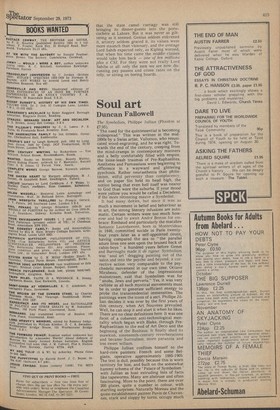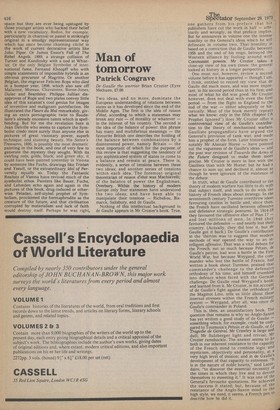Soul art
Duncan Fallowell
The Symbolists, Philippe Jullian (Phaidon at £7.95). • " The need for the quintessential is becoming widespread." This was written in the mid1890s by a Swiss artist, Vallotton, who resusicated wood-engraving, and he was right. To wards the end of the century, creeping from the mind-cramps in contemporary manners and a belly comfortably filled with empire, the loose-leash traumas of Pre-Raphaelites, Aesthetes and Parnassians were beginning to effloresce in a wayward and glittering pyschosis. Rather neurasthenia than philistinisrn, wilful perversity than complacency, and on paper Sin held its head high, the notion being that even hell itself was nearer to God than were the suburbs. If your mood were yellow you would be called a Decadent. if the more retreating mauve a Symbolist.
it had many deities, but since it was as much a movement in belief and behaviour as in art, the strong literary infusions are automatic. Certain writers were too much however and had to await Andre Breton for embrace: Rimbaud and particularly the macabre fantastic Lautreamont, horn in Montevideao in 1846, committed sucide in Paris twentyfour years later as a self-appointed count, having compared the sea to "the parallel azure lines one sees upon the bruised back of cabin-boys" a hundred years before Genet and Burroughs made it de rigenr. Symbolism was 'soul art' dragging painting out of the salon and into the psyche and beyond, a corrective action very comparable to the psychedelic movement in our own time. Octave Mirabeau, defender of the Impressionist mainstream, said that Symbolism was for "snobs, Jews and perverts." Yes, it was very cultiste as all such mystical movements must be in order to generate sufficient energy to probe the transcendential immensities, The paintings were the icons of a sect. Phillipe Jillian decides it was over by the first years of this century, when Art Nouveau prevailed. Well, he can stop it and start it when he likes. There are no clear definitions here. It was one facet of a coherent anti-technological mentality which began with Blake, through PreRaphaelitism to the end of Art Deco and the beginning of the Bauhaus. It finally shed its mawkish, nineteenth-century reverberations and became Surrealism, more paranoia and less sweet william.
Philippe Jullian confines himself to the hard-core painters: French and some Belgians, operative approximately 1885-1905. The text is dull, possibly because this is worn territory for him, and built on the somewhat hammy schema of the' Palace of Symbolism' with Jullian as host extruding lists of facts like tapeworms. Many are abstruse and often fascinating. More to the point, there are over 200 plates, quite a number in colour, with startling surprises. Naturally Moreau and the quasi-establishment painter Puvis de Chavannes, stark and sloppy by turns, occupy much
space but they are ever being upstaged by those younger artists who backed their belief with a new vocabulary. Redon, for example, particularly in charcoal or pastel is strikingly original in a smudgy representational way which has since become charming cliche in the work of current decorative artists like John Piper. Or James Ensor's Fall of The Rebel Angels, 1889, a strange collision of Turner and Kandinsky with a nod at Whistler, Or the only Belgian Symbolist of international fame, Fernand Khnopff who with simple statements of impossible hybrids is an obvious precursor of Magritte. Or another Belgian, the engraver Felicien Roos who died in a bumper year, 1898, which also saw off Mallarme, Moreau, Cheyennes, Burne-Jones, Dulac and Beardsley. Philippe Jullian disapproves of Rops and two plates convey little idea of this satanist's cool genius for images of inventive and malignant putrefaction. He illustrated the Fleurs du Mal remarkably, giving an extra pornographic twist to Baude!sire's already excessive taints which is spellbinding. But for me the revelation here is Jean Delville who seems to capture the Symbolist credo more surely than anyone else in pictures of great visionary power, superb technique, and stunning beauty. His Satan's Treasures, 1895, is possibly the most dramatic painting in the book, and one of very few to generate the mystery they sought. With its swirling reds, golds, black, and green sky, it could have been painted yesterday in Vienna. by someone like Fuchs, drawings like Tristan and Yseult, or the extraordinary Idol of Perversity equally so. Today the Fantastic Realists of Vienna have revived much of the symbolist ethos. Painters like Bauer, Fuchs, and Lehmden echo again and again in the pictures of this book, drug-induced or otherwise. Peladen, self-styled prophet of Symbolism, proclaimed the hermaphrodite as the creature of the future, and that civilisation corrupted by materialism and lack of faith would destroy itself. Perhaps he was right.











































 Previous page
Previous page